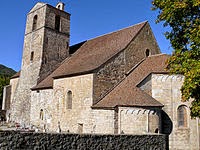In 2014 the procedure for the beatification and canonisation was set in motion in Marseilles for Anne-Madeleine Rémuzat (1696-1730), Visitandine nun, visionary and propagatrice of the Cult of the Sacred Heart. On the face of it, it is hard to see why this has taken so long; it would seem Anne-Madeleine has all the prerequisites for a Catholic saint - miraculous visions, asceticism, determined prosecution of her mission.
 In fact, of course,it is far from that easy. There is a very specific and labyrinthine set of rules, with clearly laid down stages and a number of hoops to jump through before anyone becomes a saint. Unless an individual is "fast-tracked" like JPII, it can be a very prolonged process indeed.
In fact, of course,it is far from that easy. There is a very specific and labyrinthine set of rules, with clearly laid down stages and a number of hoops to jump through before anyone becomes a saint. Unless an individual is "fast-tracked" like JPII, it can be a very prolonged process indeed.
The "Cause" of Anne-Madeline Rémuzat has begun, and stalled, on two previous occasions, one in the 1890s, and one in the 1920s. However, procedures were radically overhauled in 1983 which means that, although Anne-Madeleine was declared a Venerated Servant of God by Leo XIII in December 1891, the whole process must be restarted. You can see the exact stages involved in her entry from the Hagiography Circle database:
1) 15 February in Marseilles, Bouches-du-Rhône (France)
professed religious, Visitation Nuns
born: 29 November 1696 in Marseilles, Bouches-du-Rhône (France)
competent forum: Marseilles
CCS protocol number: 2995
type of cause: heroic virtues
opening of informative process:
closing of informative process:
decree on writings:
introduction of cause: 24 December 1891
decree « non cultu »:
opening of apostolic process:
closing of apostolic process:
decree on validity of informative and apostolic processes: 14 January 1906
antepreparatory congregation: 08 March 1921
nihil obstat: 18 February 2013
opening of diocesan inquiry: 15 February 2014
closing of diocesan inquiry:
decree on validity of diocesan inquiry:
submission of Positio to CCS:
session of historical consultants:
particular meeting of theological consultors:
session of cardinal and bishop members of the CCS:
postulator: Mons. Jean-Pierre Ellul
petitioner: Association Anne-Madeleine Rémuzat, 2bis, rue St Adrien, 13008 Marseille, FRANCE
The Cause has so far passed through only the preliminaries.
A postulator to oversee the proceedings was appointed in 2009, Monseigneur Jean-Pierre Ellul, Rector of the Basilica of the Sacred-Heart in Marseilles. In February 2014 the Roman Dicasteries gave their formal permission to proceed (nihil obstat - "nothing stands in the way"). On 15 February 2014 the diocesan inquiry opened in order to begin assembling the relevant documentation and testimony. If all goes well, the Cause will in due course be referred to the Roman Congregation for the Causes of Saints for further investigation and adjudication. To achieve Beatification, the first stage on the way to Sainthood, there must be an approved miracle, which is evidence of the intercessionary powers of the individual and thus of their union after death with God. In practice this is almost always a miracle of healing. A second miracle is necessary for subsequent canonisation.

Like so many aspects of Catholicism, the proceedings are a weird combination of medieval mindset and bright modernity; as part of the appeal for evidence Anne-Madeleine now has an officially recognised blog and a Facebook page. However, the task facing Mgr Ellul is daunting. Anne-Madeleine's life is not well documented. A Vie was published in 1760, only thirty years after her death, but the sources on which it was based have largely been destroyed during the Revolution. The blog maintains that posthumously "many miracles have been attributed to her" but is ominously short on specifics.
The only published fruit of the diocesan inquiry so far has been a report on the biomedical examination, begun in December 2011, of the heart of Anne-Madeleine, preserved in a reliquary in the Basilica. After Anne-Madeleine's death, the customary autopsy had revealed various marks of sanctity, including a small raised and inflamed area on her chest corresponding to the pain she had felt when Jesus mystically placed her heart within his. Sadly, this new investigation has yielded nothing so mysterious, nor has it corroborated the idea that the heart had been miraculously preserved. The report concludes that the heart had not been naturally (that is to say "miraculously") conserved but merely embalmed according to the practices of the time, using myrtle honey and lime.
References
 "Anne-Madeleine Rémuzat" on Hagiography Circle
http://newsaints.faithweb.com/year/1730.htm
"Anne-Madeleine Rémuzat" on Hagiography Circle
http://newsaints.faithweb.com/year/1730.htm
Soeur Anne-Madeleine REMUZAT (Official blog)
http://annemadeleineremuzat.over-blog.fr/
(See particularly the comments of Mgr Ellul:
http://annemadeleineremuzat.over-blog.fr/article-le-postulateur-de-la-cause-d-anne-madeleine-114441512.html)
Facebook page (now abandoned?, but interesting photo albums):
https://www.facebook.com/pages/Vers-la-Canonisation-dAnne-Madeleine-R%C3%A9muzat/114249881984722
Philippe Charlier et al., "The heart of Blessed Anne-Madeleine Rémuzat: a biomedical approach of “miraculous” heart conservation", Cardiovascular Pathology, 21 July 2014
http://www.researchgate.net/profile/Philippe_Charlier2/publication/264241888_The_heart_of_Blessed_Anne-Madeleine_Remuzat_a_biomedical_approach_of_miraculous_heart_conservation/links/54328c8c0cf225bddcc7b578.pdf
Life of Anne-Madeleine Rémuzat:
The most accurate account is now the Blog biography:
http://annemadeleineremuzat.over-blog.fr/article-portrait-d-anne-madeleine-remuzat-70559818.html
See also
" Anne-Madeleine Rémuzat", La dévotion au Sacré-Cœur
http://www.spiritualite-chretienne.com/s_coeur/biogra_e.html#Remuzat
A less reverential assessment can be found in: Raymond Anthony Jonas, France and the Cult of the Sacred Heart: An epic tale for modern times (Univ. of Washington Press; 2001) [Relevant extracts on Google Books]




















